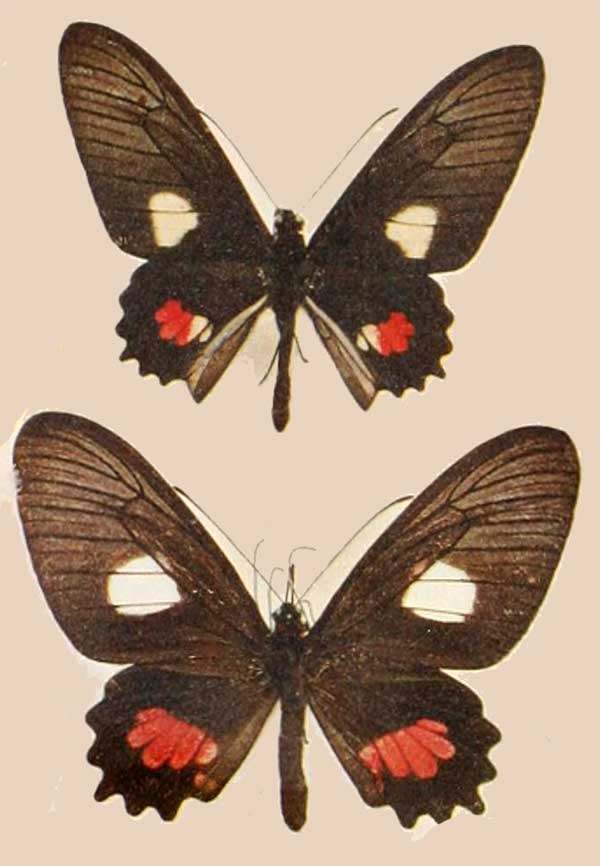
Superregnum: Eukaryota
Cladus: Unikonta
Cladus: Opisthokonta
Cladus: Holozoa
Regnum: Animalia
Subregnum: Eumetazoa
Cladus: Bilateria
Cladus: Nephrozoa
Cladus: Protostomia
Cladus: Ecdysozoa
Cladus: Panarthropoda
Phylum: Arthropoda
Subphylum: Hexapoda
Classis: Insecta
Cladus: Dicondylia
Subclassis: Pterygota
Cladus: Metapterygota
Infraclassis: Neoptera
Cladus: Eumetabola
Cladus: Endopterygota
Superordo: Panorpida
Cladus: Amphiesmenoptera
Ordo: Lepidoptera
Subordo: Glossata
Cladus: Coelolepida
Cladus: Myoglossata
Cladus: Neolepidoptera
Infraordo: Heteroneura
Cladus: Eulepidoptera
Cladus: Ditrysia
Cladus: Apoditrysia
Cladus: Obtectomera
Superfamilia: Papilionoidea
Familia: Papilionidae
Subfamilia: Papilioninae
Tribus: Troidini
Subtribus: Troidina
Genus: Parides
Species: Parides pizarro
Name
Parides pizarro (Staudinger, 1884)
Parides pizarro is a species of butterfly in the family Papilionidae. It is found in Colombia, Brazil, Bolivia and Peru.
Description
Abdomen in the male quite black, in the female with a red spot before the apex on the underside. Forewing without spots, also none in the fringes. Hindwing with whitish yellow area, which in the male consists of three or four spots, in the female of three to six. A full description is provided by Rothschild, W. and Jordan, K. (1906)[3]
Taxonomy
Parides pizarro is a member of the chabrias species group[4]
The members are
Parides chabrias
Parides coelus
Parides hahneli
Parides mithras
Parides pizarro
Parides quadratus
Status
A rare species. Protected in Tambopata National Reserve in Peru.[5]
Subspecies
Parides pizarro pizarro (Staudinger, 1884)
Parides pizarro kuhlmanni (E. May, 1925)
Parides pizarro steinbachi (Rothschild, 1905) [6] Forewing in both sexes with a large white spot before hind margin; hindwing with a red band. Bolivia.[7]
Etymology
Named for Francisco Pizarro.
References
Grice, H.; Freitas, A.V.L.; Rosa, A.; Dias, F.M.S.; Mega, N.; Marini-Filho, O.; Casagrande, M.; Mielke, O. (2019). "Parides pizarro". IUCN Red List of Threatened Species. 2019: e.T16244A145166386. doi:10.2305/IUCN.UK.2019-1.RLTS.T16244A145166386.en. Retrieved 17 November 2021.
Staudinger, 1884 Exotische Tagfalter in sysmatischer Reihenfolge mit Berücksichtigung neuer Arten in Staudinger & Schatz, Exotische schmetterlinge
Rothschild, W. and Jordan, K. (1906). A revision of the American Papilios. Novitates Zoologicae 13: 411-752. (Facsimile edition ed. P.H. Arnaud, 1967) and online
Edwin Möhn, 2007 Butterflies of the World, Part 26: Papilionidae XIII. Parides Verlag Goecke & Evers Verlag Goecke & Evers ISBN 9783937783277
Collins, N. Mark; Morris, Michael G. (1985). "Parides pizarro (Staudinger, 1890)". Threatened Swallowtail Butterflies of the World: The IUCN Red Data Book. Gland & Cambridge: IUCN. p. 68. ISBN 978-2-88032-603-6 – via Biodiversity Heritage Library.
Rothschild, W. & Jordan, K. (1906). "A revision of the American Papilios". Novitates Zoologicae. 13: 411-752. (Facsimile edition ed. P.H. Arnaud, 1967) Public Domain This article incorporates text from this source, which is in the public domain.
Seitz, A. ed. Band 1: Abt. 1, Die Großschmetterlinge des palaearktischen Faunengebietes, Die palaearktischen Tagfalter, 1909, 379 Seiten, mit 89 kolorierten Tafeln (3470 Figuren) Public Domain This article incorporates text from this source, which is in the public domain.
Lamas, Gerardo (2004). Atlas of Neotropical Lepidoptera; Checklist: Part4A Hesperioidea–Papilionoidea. Gainesville, Florida: Scientific Publishers, Inc. p. 93. ISBN 978-0-945417-28-6.
Retrieved from "http://en.wikipedia.org/"
All text is available under the terms of the GNU Free Documentation License

